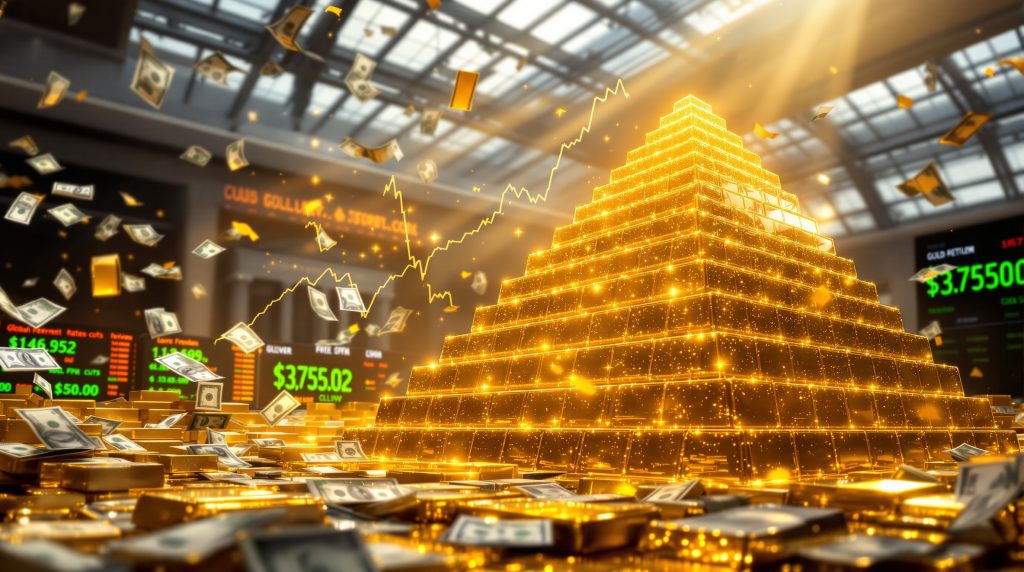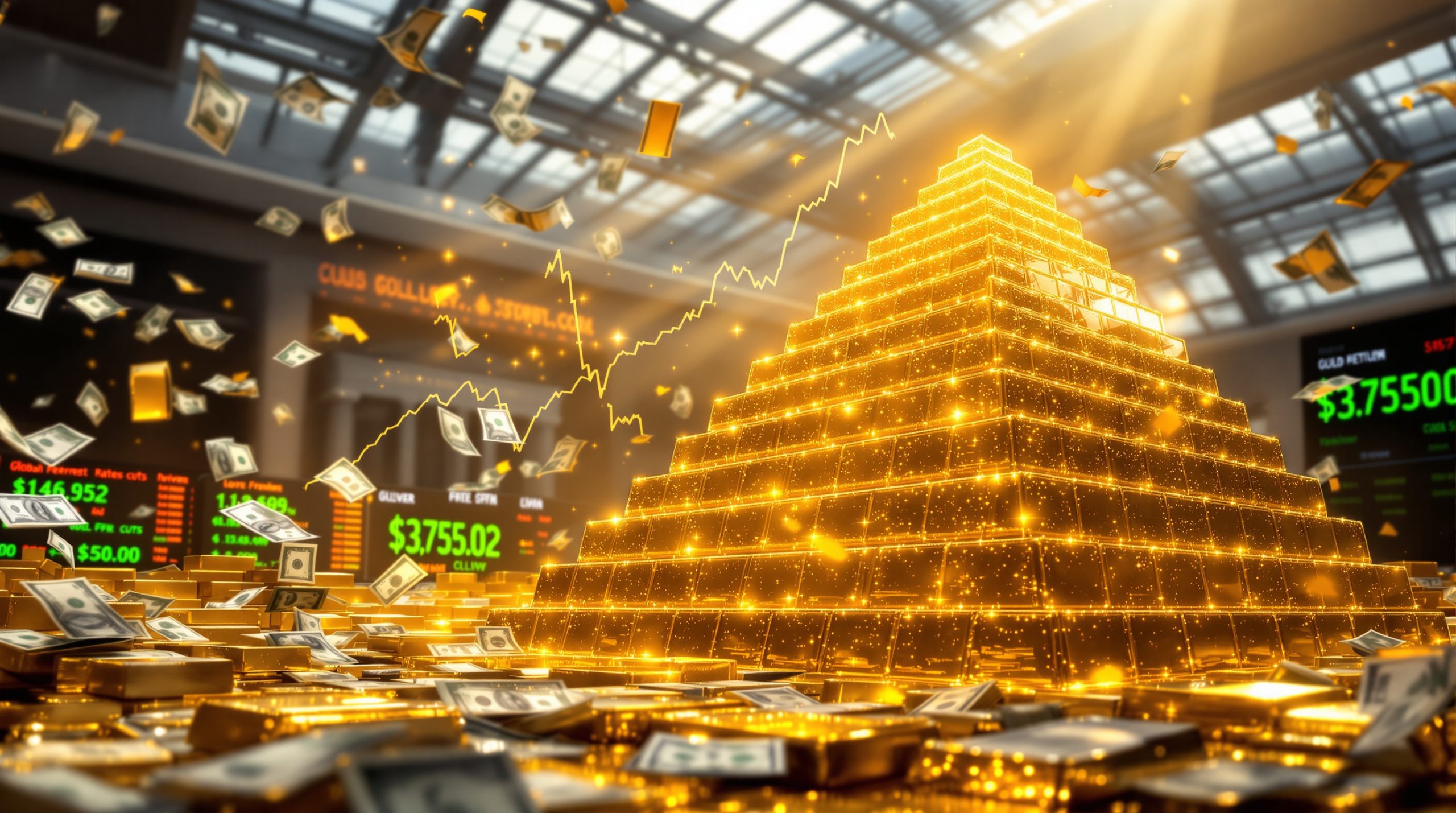Gold Hits Record High: Why Precious Metals Are Soaring in 2025
The precious metals market has witnessed extraordinary momentum in 2025, with gold reaching unprecedented price levels that have captivated investors worldwide. This remarkable rally reflects a complex interplay of economic factors, monetary policy shifts, and persistent global uncertainties.
The Current Gold Price Milestone
Gold has achieved a historic milestone, reaching $3,759.02 per ounce in September 2025. This remarkable achievement surpasses the previous inflation-adjusted peak from January 1980, marking a significant moment for precious metals investors and market observers alike.
COMEX gold futures contracts have similarly climbed to $3,757.60, while spot gold maintains strong positioning at $3,743.39 per ounce according to recent market data. The December delivery futures trading at $3,779.50 signals continued bullish sentiment among market participants.
This price trajectory represents more than just a number—it reflects fundamental shifts in how investors perceive gold's role in modern portfolios amidst evolving economic conditions. The historic gold surge has captured global attention as investors seek stability in uncertain times.
Economic Indicators Supporting Gold's Rise
Several economic factors have converged to fuel gold's impressive performance. The Federal Reserve's recent 25 basis point interest rate cut has significantly altered the investment landscape, creating more favorable conditions for non-yield-bearing assets like gold.
A weakening U.S. dollar index has further enhanced gold's appeal, particularly among international investors seeking to diversify their holdings away from dollar-denominated assets. Currency depreciation historically correlates with stronger precious metals prices, and the current market environment follows this pattern.
Market expectations indicate a 90% probability of another rate cut in October, with investors pricing in a 75% chance of additional easing in December. This anticipated monetary policy trajectory provides structural support for gold price analysis moving forward.
Despite central bank interventions, persistent inflation concerns continue to drive investors toward traditional stores of value. When real returns on interest-bearing assets turn negative (nominal rates minus inflation), gold typically outperforms as it maintains purchasing power over time.
How Are Interest Rate Policies Affecting Precious Metals?
Federal Reserve's Shifting Monetary Stance
The Federal Reserve has pivoted from the restrictive policy stance that characterized previous years, initiating what many analysts anticipate will be a sustained easing cycle. This shift represents a critical inflection point for precious metals markets.
Fed officials have expressed divergent views on the appropriate pace of monetary easing. New Federal Reserve Governor Stephen Miran has warned about misreading monetary policy tightness, suggesting that aggressive rate cuts are necessary to protect labor market stability. This view has been countered by colleagues advocating a more cautious approach, highlighting ongoing internal debates about inflation risks.
These policy disagreements reflect the challenging balancing act facing central bankers—maintaining price stability while supporting economic growth. Powell's upcoming speech is highly anticipated for additional guidance on the Fed's monetary policy trajectory through 2025-2026.
Impact of Rate Cuts on Gold Valuation
Lower interest rates fundamentally reduce the opportunity cost of holding non-yielding assets like gold. When bonds and savings accounts offer diminished returns, gold's appeal as a store of value increases proportionally.
The bond yield competition naturally decreases as rates fall, making gold more attractive on a relative basis. This relationship helps explain why gold often performs strongest during the early stages of rate-cutting cycles.
Historical analysis demonstrates that monetary easing typically correlates with sustained precious metal rallies. The weakening of currency values that accompanies expansionary monetary policy tends to boost dollar-priced commodities, creating favorable conditions for gold forecast trends.
Investment flows are increasingly shifting from fixed income to alternative stores of value, as portfolio managers reassess allocation strategies in light of changing interest rate dynamics.
Why Is Gold Rising Despite Strong Equity Markets?
The Unusual Market Correlation
One of the most notable aspects of the current gold rally is its coincidence with equity market strength. Traditionally, gold and stocks often move inversely, with gold serving as a safe haven during equity market turbulence.
The S&P 500 reaching all-time highs simultaneously with gold's record performance represents an unusual market dynamic. This concurrent strength indicates investors are displaying both risk-on appetite and defensive positioning—a dual sentiment that reflects both economic optimism and underlying uncertainty about future market conditions.
Portfolio diversification strategies have gained prominence among institutional investors, who increasingly view gold as a complementary rather than alternative asset to equities. This perspective shift represents an evolution in modern portfolio theory that accommodates gold's unique characteristics as both a diversifier and potential return enhancer.
The dual market strength suggests investors are hedging against potential market corrections while still participating in equity gains—a sophisticated approach that acknowledges the complex risk landscape of today's investment environment.
Technical Analysis of Gold's Price Movement
From a technical perspective, the short-term bullish trend remains intact despite potential pullbacks. Key support levels have been identified at $3,710 and $3,690, providing technical floors that may contain corrections.
As noted by OANDA senior market analyst Kelvin Wong, "The short-term trend is still bullish intact, but on an intraday basis, we do expect a short-term pullback more due to technical factors."
Momentum indicators suggest possible consolidation after the recent record highs, allowing the market to digest gains before potentially resuming the upward trajectory. Trading volumes have notably increased during price surges, confirming strong buying interest and validating the sustainability of the current rally.
Technical resistance levels continue to be broken in this market environment, illustrating the fundamental strength underlying price movements rather than merely speculative activity.
What's Happening with Other Precious Metals?
Silver's Impressive Performance
Silver prices have approached 14-year highs at $43.67 per ounce, demonstrating even greater percentage gains than gold in recent months. This outperformance has narrowed the silver-to-gold ratio, a key metric watched by precious metals investors.
The dual nature of silver—functioning as both an industrial metal and investment asset—has created a powerful demand dynamic. Industrial applications continue to expand, particularly in renewable energy technologies, electronics, and medical applications, providing fundamental support beyond investment demand.
Supply constraints in silver mining have added pressure to available inventory, with primary silver mines facing declining ore grades and production challenges. The resulting supply-demand imbalance has contributed to silver's strong price performance.
ANZ Research notes that "Investment demand will continue to drive silver prices as long as gold shines," highlighting the interconnected nature of precious metals markets.
Platinum and Palladium Market Dynamics
Platinum has demonstrated remarkable resilience, trading at $1,412.80 despite various economic headwinds. Its industrial applications, particularly in automotive catalytic converters, provide fundamental support while investment demand adds momentum.
Palladium prices have stabilized at $1,176.44 after previous volatility, finding equilibrium between industrial demand fluctuations and investment flows. The automotive sector's transition toward different emission-control technologies has created evolving demand patterns for platinum group metals.
Mining production challenges, particularly in South Africa where labor disputes and electricity supply issues have disrupted operations, continue to affect the supply-side economics of these metals. Recycling rates have increasingly influenced available market supply for platinum group metals, adding another variable to price dynamics.
How Are Global Economic Conditions Influencing Gold?
Labor Market Concerns and Monetary Policy
Weakening employment data has prompted the Federal Reserve to prioritize job market support in its policy considerations. This emphasis on labor market stability provides structural support for accommodative monetary policy, which historically benefits gold prices.
Powell's recent comments have highlighted labor market conditions as a key factor guiding future rate decisions. This creates a feedback loop where weaker employment data may accelerate rate cuts, potentially strengthening the case for gold in investment portfolios.
The central bank faces a delicate balancing act between inflation control and employment stability. Historical precedent demonstrates that gold typically demonstrates strength during periods of labor market uncertainty, as monetary policy responses to employment weakness tend to favor precious metals.
Wage growth patterns directly affect inflation expectations and, by extension, monetary policy decisions. The interplay between wage data, inflation metrics, and interest rate policy creates a complex environment in which gold often thrives.
Inflation Persistence and Safe-Haven Appeal
Despite the rate-cutting cycle, "sticky" inflation remains a concern for policymakers and investors alike. Core inflation measures continue to exceed the Fed's long-term target, creating an environment where real interest rates (nominal rates minus inflation) remain negative.
Negative real rates create a historically favorable environment for precious metals performance. When traditional interest-bearing investments fail to preserve purchasing power due to inflation exceeding yields, gold's appeal as an inflation hedge increases substantially.
On an inflation-adjusted basis, gold's returns have become increasingly attractive compared to fixed income, driving allocation shifts among institutional investors. This fundamental relationship between inflation, interest rates, and gold prices underpins much of the current rally, as explained in a recent Reuters analysis.
What Role Does Geopolitical Uncertainty Play?
International Tensions and Market Anxiety
The shifting geopolitical landscape has increased demand for crisis-resistant assets like gold. International tensions, trade disputes, and regional conflicts have elevated the geopolitical risk premium embedded in gold prices.
Recent discussions regarding potential tariffs on gold imports have created additional market dynamics, with gold futures climbing notably after reports of U.S. tariff considerations on 1-kg gold bars.
Global central bank gold purchasing continues at elevated levels, reflecting a strategic diversification away from traditional currency reserves. This official sector demand provides structural support for gold prices independent of retail and institutional investment flows.
Sovereign wealth funds have accelerated their diversification away from traditional currencies, seeking to reduce exposure to geopolitical and monetary risks through increased gold allocation. Political transitions and elections worldwide have contributed to market volatility that typically favors gold.
Currency Debasement Concerns
Expanding global debt levels have raised legitimate questions about fiat currency stability. Government borrowing has reached unprecedented levels in many major economies, creating long-term concerns about currency purchasing power.
Major economies continue to maintain expansionary fiscal policies despite inflation concerns, prioritizing growth over immediate price stability. This policy approach has historically benefited precious metals as stores of value.
Central bank balance sheets remain significantly larger than pre-pandemic levels, with monetary authorities reluctant to meaningfully reduce their holdings of government securities. This structural change in monetary conditions provides underlying support for gold bonds dynamics as an alternative monetary asset.
Competitive currency devaluation concerns among major trading partners have resurfaced in policy discussions, reflecting the interconnected nature of global currency markets and their impact on trade relationships.
What Are Investment Experts Saying About Gold's Future?
Market Analyst Perspectives
Technical analysts have identified potential for continued upward momentum in gold prices, with price targets being revised upward following the recent breakout. The breach of previous resistance levels is viewed as technically significant, potentially clearing the path for further gains.
OANDA senior market analyst Kelvin Wong has noted the bullish trend remains intact, despite potential short-term pullbacks. This technical perspective aligns with fundamental analysis suggesting structural support for higher gold prices.
ANZ research has highlighted economic growth concerns as supporting gold demand, noting that slowing economic growth, higher inflation, and the shifting geopolitical landscape will likely maintain strong investment interest in precious metals.
Investment banks have revised their price targets upward following the recent breakout, with several major institutions projecting continued strength through 2025-2026. A consensus has formed around sustained demand for precious metals in the current economic environment, as Investopedia reports.
Institutional Positioning in Gold Markets
ETF holdings of physical gold have increased after previous outflows, signaling renewed institutional interest in the sector. These investment vehicles provide an important barometer of institutional sentiment toward gold.
The futures market shows growing net long positions among speculative traders, reflecting positive sentiment among professional investors. This positioning data provides insight into market expectations regarding gold's near-term direction.
Central bank gold purchases continue at historically elevated levels, with official sector buying providing structural support for prices. This diversification trend among monetary authorities represents a significant shift in global reserve asset management.
Institutional investors have increased portfolio allocations to precious metals, seeking to enhance diversification and inflation protection. Wealth management firms increasingly recommend gold exposure for client portfolios, acknowledging its role in modern asset allocation strategies.
How Can Investors Participate in the Gold Market?
Physical Gold Investment Options
Gold bullion bars and coins offer direct ownership with various considerations regarding storage, insurance, and liquidity. These traditional forms of gold ownership provide tangible assets without counterparty risk, appealing to investors seeking direct exposure.
Premium variations between different physical gold products can significantly affect returns, with smaller units typically commanding higher premiums over spot prices. Understanding these pricing dynamics is essential for optimizing physical gold investments.
Storage and insurance costs impact the long-term economics of physical gold holdings, requiring consideration of secure storage options ranging from home safes to professional vaulting services. These ongoing expenses should be factored into total return calculations.
Liquidity differences between various physical gold investment formats can affect the ease of buying and selling positions. Widely recognized products from major refiners and government mints typically offer superior liquidity compared to obscure or unusual formats.
Authentication and purity verification requirements present additional considerations for physical gold transactions, with professional assay services sometimes necessary for larger transactions or unusual products.
Financial Instruments for Gold Exposure
Gold ETFs provide exchange-traded exposure without the complexities of physical handling, offering efficient market access with minimal storage concerns. These investment vehicles have democratized gold ownership, making it accessible to a broader investor base.
Futures contracts offer leveraged positions with specific considerations regarding margin requirements and rollover mechanics. These derivative instruments appeal to professional traders seeking to maximize capital efficiency or implement sophisticated trading strategies.
Mining stocks provide operational leverage to gold price movements, potentially outperforming the metal itself during bull markets but introducing company-specific risks. The selection process requires analysis of production costs, reserve quality, and management effectiveness.
Royalty and streaming companies offer alternative exposure to the sector with unique risk-reward characteristics. These businesses provide upfront capital to miners in exchange for the right to purchase future production at predetermined prices, creating a hybrid business model.
Options strategies allow for various risk/reward profiles in gold markets, enabling precise positioning based on price expectations, volatility forecasts, and risk tolerance. These sophisticated instruments require advanced understanding of options mechanics and pricing models.
What Historical Lessons Apply to the Current Gold Rally?
Previous Gold Bull Markets
Comparing the current rally to the 1970s inflation-driven gold market reveals both similarities and differences. While both periods feature monetary expansion and inflation concerns, today's environment includes unprecedented central bank intervention and more sophisticated market structures.
The 2008-2011 financial crisis gold price surge provides another relevant comparison, as both periods feature significant monetary easing and financial system concerns. However, the current rally occurs against a backdrop of stronger equity markets and different inflation dynamics.
Analysis of the 2020 pandemic-related precious metals performance offers insights into market behavior during crisis periods. The rapid monetary and fiscal response to COVID-19 created conditions that initially supported gold before a period of consolidation and the current breakout.
Common factors across historical gold bull markets include monetary easing, inflation concerns, and geopolitical uncertainty—all present in today's market environment. The duration and magnitude patterns from previous sustained rallies suggest potential for continued strength if historical patterns hold.
Economic Cycle Positioning
Gold's performance across different phases of economic cycles reveals its complex relationship with broader economic conditions. While often viewed as a recession hedge, gold can perform well during various economic environments depending on monetary policy, inflation trends, and investor sentiment.
The correlation between monetary policy transitions and gold prices has been well-documented, with gold typically performing strongly during the early stages of easing cycles. The current Fed pivot appears to follow this historical pattern.
Leading economic indicators suggest potential economic slowdown ahead, creating conditions that have historically supported gold prices. If economic deceleration prompts more aggressive monetary easing, precious metals may benefit from both safe-haven flows and policy support.
Historical analysis of gold's performance during periods of labor market weakness demonstrates its potential as a portfolio stabilizer during economic transitions. Gold's low correlation with traditional financial assets enhances its diversification benefits during periods of market stress.
What Are the Risks to the Current Gold Rally?
Potential Headwinds for Gold Prices
The possibility of inflation moderating faster than expected represents a potential risk to the gold rally. If price pressures ease significantly, the Fed might slow or pause its easing cycle, potentially reducing gold's appeal.
Central banks maintaining higher rates for longer than markets currently anticipate could create headwinds for gold. Current pricing reflects expectations for continued easing that may not materialize if inflation proves persistent.
Potential dollar strength, particularly if other major economies weaken more significantly than the U.S., could pressure gold prices. The inverse relationship between the dollar and gold means unexpected currency strength might challenge the current rally.
Technical overbought conditions could potentially trigger corrections after such a strong advance. Momentum indicators suggest some froth in the market that might need to dissipate through either price corrections or time consolidation.
Profit-taking pressure may emerge after reaching psychological price levels, as traders lock in gains following the achievement of round-number milestones. These technical factors often create short-term volatility within longer-term trends.
Long-term Fundamental Considerations
Mining production capacity adjustments to sustained higher prices may eventually increase supply, potentially dampening price appreciation over time. The mining industry typically responds to higher prices by expanding production, though this process involves significant lag times.
Technological changes affecting industrial demand for precious metals could alter traditional supply-demand dynamics. Innovations in manufacturing processes or materials science might reduce industrial consumption of certain metals over time.
Central bank policy shifts regarding reserve asset composition could impact official sector demand. While currently supportive, changes in reserve management strategies could alter this important demand component.
Demographic trends influence jewelry and investment demand patterns over time. Aging populations in developed markets and wealth creation in emerging economies create evolving demand dynamics that will shape future market conditions.
Emerging market wealth creation affects global gold consumption, with cultural affinity for gold in countries experiencing rapid economic development potentially supporting long-term demand growth.
FAQ: Gold Investment in 2025
Is gold overvalued at current price levels?
Gold's value assessment depends on multiple factors including inflation expectations, real interest rates, currency stability, and geopolitical risks. While prices have reached record levels, fundamental support exists through negative real interest rates, ongoing economic uncertainties, and accommodative central bank policies.
Historical comparisons accounting for inflation and money supply growth suggest current prices remain reasonable relative to previous bull markets when viewed in proper context. The true measure of value requires analysis beyond nominal price levels to examine gold's relationship with other financial assets and economic indicators.
How does gold perform during economic recessions?
Gold has often performed well during recessions, though not uniformly across all economic downturns. Its performance typically depends on monetary policy responses, prevailing interest rates, and investor sentiment. During periods of financial stress, gold frequently benefits from safe-haven flows and monetary easing.
The metal's low correlation with traditional financial assets enhances its appeal during economic contractions, as portfolio diversification benefits become more pronounced. However, liquidity needs during severe market dislocations can sometimes pressure gold prices temporarily before longer-term fundamentals reassert themselves.
What's the relationship between gold and silver prices?
Silver typically exhibits higher volatility than gold, often amplifying gold's price movements in either direction. The gold-to-silver ratio (the amount of silver needed to purchase one ounce of gold) fluctuates based on industrial demand, investment flows, and relative supply dynamics.
Currently, silver shows strong performance alongside gold, with its dual role as industrial metal and investment asset creating multiple demand drivers. When gold trends strongly in either direction, silver typically follows with greater percentage moves due to its smaller market size and industrial demand component.
How might further interest rate cuts affect gold prices?
Additional rate cuts would likely support gold prices by reducing the opportunity cost of holding non-yielding assets and potentially weakening the U.S. dollar. However, market expectations already price in significant easing, so the impact of future cuts may depend on their magnitude relative to expectations.
The pace and communication surrounding future cuts will influence market reactions. Faster-than-expected easing would likely boost gold, while a more gradual approach might produce muted responses if already anticipated by market participants. Developing effective investment strategies that account for these variables will be crucial for investors in this environment.
Ready to Spot the Next Major Gold Discovery?
Get instant notifications on significant ASX mineral discoveries with Discovery Alert's proprietary Discovery IQ model, turning complex data into actionable investment opportunities. Visit our dedicated discoveries page to understand how early identification of major mineral finds can lead to exceptional returns, and begin your 30-day free trial today.




